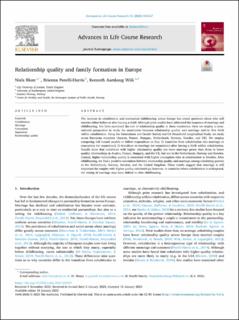Relationship quality and Family Formation in Europe
Peer reviewed, Journal article
Published version
Permanent lenke
https://hdl.handle.net/11250/3075402Utgivelsesdato
2023Metadata
Vis full innførselSamlinger
- Artikler / Journal articles [426]
- Publikasjoner fra Cristin [138]
Originalversjon
10.1016/j.alcr.2023.100527Sammendrag
The increase in cohabitation and nonmarital childbearing across Europe has raised questions about who still marries either before or after having a child. Although prior studies have addressed the sequence of marriage and childbearing, few have examined the role of relationship quality in these transitions. Here we employ a cross-national perspective to study the association between relationship quality and marriage and/or first birth within cohabitation. Using the Generations and Gender Survey and UK Household Longitudinal Study, we study seven European countries (Austria, France, Hungary, Netherlands, Norway, Sweden, and UK). We employ competing risk hazard models to follow respondents as they 1) transition from cohabitation into marriage or conception (or separation); 2) transition to marriage (or separation) after having a birth within cohabitation. Results show that cohabitors with higher relationship quality are more marriage prone than those in lower quality relationships in Austria, France, Hungary, and the UK, but not in the Netherlands, Norway and Sweden. Instead, higher relationship quality is associated with higher conception risks in cohabitation in Sweden. After childbearing, we find a positive association between relationship quality and marriage among cohabiting parents in the Netherlands, Norway, Sweden, and the United Kingdom. These results suggest that marriage is still important for couples with higher quality relationships; however, in countries where cohabitation is widespread, the timing of marriage may have shifted to after childbearing.
